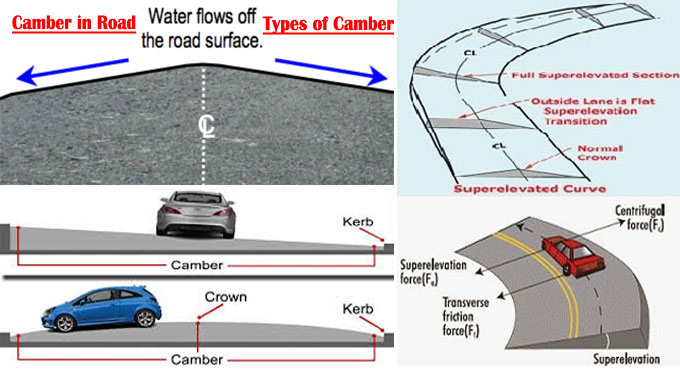
Detailed information about Camber in Road

Camber is found on the highways. The slope from diagonal direction is called camber. Cambers mainly drain out the rain water from the road surface. Camber provides the road surface by draining out the rainwater out of the road. It is also called a cross slope of the road.
The rate of camber is normally indicated by 1 : n ( 1 in n ) (1 vertical to n horizontal) or in proportions as n % (for instance, 1 in 50 or 2 %). The design values of camber is mainly based on pavement?s type and the amount of rainfall in the area.
Cambers are very useful to eliminate the surface water. But these are not recommended for wearing down the surface. Cambers of slope 2 to 3% are arranged.
Types of Camber
Composite Camber
Composite camber is a combination of partly parabola and partly straight line which have different slopes. The central part of the road is made of parabolic and it is provided with straight slopes near the edges. By increasing the contact area of the wheel camber helps to decrease the intensity of pressure.
Sloped or Straight Camber
This type of camber is made by meeting two straight surfaces in the crown. Crown is the central point in the surface of the road. The shape of the edges make difficulties for the traffic. That is why it is not used frequently.
Two Straight Line Cambers
This type of camber is made of straight lines steeper near the edges. This type of camber is best for Indian roads.
Barrel Camber
This type of camber consists of a continuous curve. The curve is either parabolic or elliptical. This type of camber is mainly used for those roads where fast moving vehicles pass frequently.
Purpose of Camber
1. It is used to prevent the surface water from subgrade soil through the pavement.
2. It is used to prevent the water to the bituminous pavement layers.
3. It is used for removing the rainwater from the pavement surface very quickly and allows the pavement for getting dry after the rain.
Advantages of Camber
1. It prevents rainwater to pile up at local shrinkages and form water pools around the road surface. Though it is not acceptable to the public and to the road structure.
2. Camber quickly drains the rainwater. It also saves the foundation course of this road structure from the percolation of rainwater to it through the road surface.
Method of Providing Camber
Generally, the camber is provided on the straight roads. It is provided by raising the center of the road with respect to the edges. It also forms the highest point on the center-line.
At horizontal curves, by raising the outer edge of the pavement with respect to the inner edge while providing this desired superelevation the surface drainage is affected.
The rate of camberis mainly designed by 1 in n, that means the transverse slope is at ratio 1 vertical to?n? horizontal. Camber can be expressed in percentage. That means if the camber is n%, the cross slope is n in 100.
Recommended Values of Camber in Road For Different Types of Road surface by IRC:
| Sr. No. | Type of Road Surface | Range of Camber in Areas of | |
| Low Rainfall | Heavy Rainfall | ||
| 1 | Cement concrete and thick bituminous surface | 1 in 60 or 1.7% | 1 in 50 or 2.0% |
| 2 | Thin bituminous surface | 1 in 50 or 2.0% | 1 in 40 or 2.5% |
| 3 | Water bound macadam and gravel pavement | 1 in 40 or 2.5% | 1 in 33 or 3.0% |
| 4 | Earth Road | 1 in 33 or 3.0% | 1 in 25 or 4.0% |
Disadvantages of Camber
1. Camber is provided to reduce the width of the road.
2. The road wears and tears on the edges.
3. Passengers feel uncomfortable during the journey.
4. Rate of accidents may increase.
If readers like this post please share your valuable feedback with us. Readers can comment in the comments section below the article.


